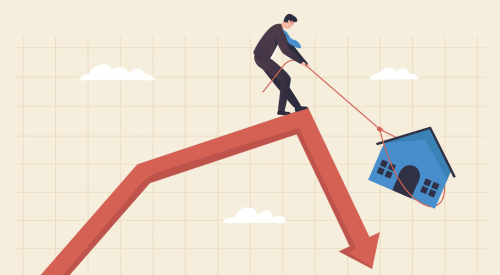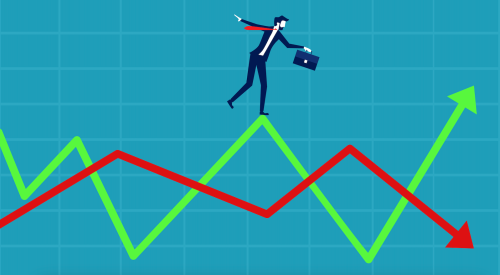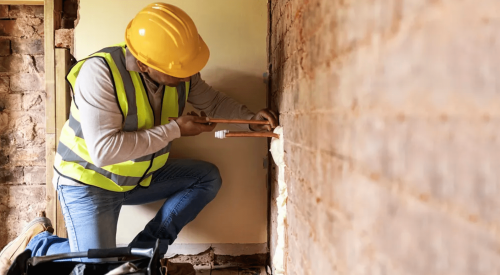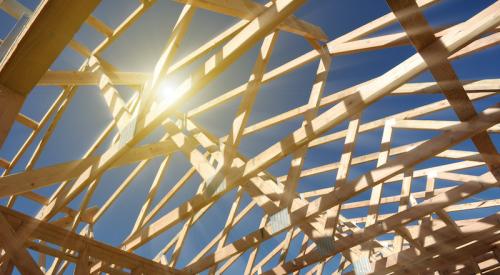After a two-year period of frenetic activity spurred by low mortgage rates and rising home prices, the housing industry has its finger on the reset button. “I think we can confidently say we're now in a housing recession,” says Robert Dietz, chief economist and SVP for Economics and Housing Policy for the National Association of Home Builders (NAHB).
As one indicator, Dietz points to the nine-month decline in single-family builder confidence tracked by the NAHB/Wells Fargo Housing Market Index (HMI), which asks respondents to rate market conditions for the sale of new homes. In September, the HMI stood at 46, after peaking at 90 in late 2020, and it was 83 in January of this year—for the HMI, anything below 50 indicates poor market conditions.
Another important indicator of housing industry health is the rate of single-family housing starts, which increased by 13% in both 2020 and 2021. NAHB forecasts a 13% decline in 2022 and an 8% decline for 2023, with the slight moderation in next year’s decline being due to the Federal Reserve pausing interest rate hikes by that time, Dietz says.
“It's virtually impossible for the economy to avoid a slowdown, given the kind of aggressive tightening the Federal Reserve is engaged in to fight inflation,” Dietz says. “Some period of 2022 or 2023 is likely to be designated as a recession.”
Other Indicators Pointing to a Housing Slowdown
Several other metrics also point to a decline in housing activity. Residential building permits dropped by 15,594, or 10.1% in August 2022, compared with the same month in 2021, according to the U.S. Census Bureau. Meanwhile, mortgage purchase applications for the week ending Sept. 9 declined by 28.7% year over year, the largest such decline since April 2020, according to the Mortgage Bankers Association. That same organization notes that refinanced mortgage activity index for the year ending Sept. 9 plummeted 83% and declined during each of the preceding five weeks.
The industry’s decline should put downward pressure on home prices. “We will finish 2022 with home prices about 10% higher than we did last year, so that gain is built into the data,” says Mike Simonsen, founder and CEO of Altos Research, a real estate data company. “But there are no signals that we will see price appreciation in 2023. And if mortgage rates kick higher, we could see pricing actually drop 5% or more across the country.” Simonsen also anticipates an increase in cancellation rates by buyers backing out of sales contracts now that mortgage interest rates have topped 7% from some lenders.
RELATED
- Lessons Learned From Previous Housing Market Disruptions
- NAHB Chairman’s Message: Members Urge Action on Housing Crisis
- 5 Unforgettable Lessons From the Great Recession
The downward housing trajectory is hitting the pocketbooks of many players in the real estate industry—builders among them. “It’s going to be increasingly more difficult to make money building houses, since rising prices have brought about a condition where supply already exceeds demand,” said John Burns, CEO of real estate research firm John Burns Real Estate Consulting.
And Linda McCoy, board president of the National Association of Mortgage Brokers, noted in a Financial Times interview that real estate agents, mortgage brokers, and appraisers are also feeling the pain. “It went from feast to famine, from everybody buying to turtle-slow,” she comments.
Bigger Concerns: Housing Slowdown Part of Greater Economic Decline
The housing industry’s decline is part of a larger trajectory for the economy as a whole. In a survey of 1,300 CEOs by audit, tax, and advisory firm KPMG, 91% of CEOs believed there will be a recession in 2023, and just 34% of them thought it would be mild and short.
But not all economists share the same view of doom and gloom. “Our baseline outlook does not call for a recession in 2023,” says Jesse Rogers, an economist at risk management company Moody’s Analytics. Although the overall U.S. economy has experienced two consecutive quarters of shrinking gross domestic product (GDP), albeit mildly so, all other indicators point to an expanding economy, he says.
A low unemployment rate (3.5%, the lowest rate since the 1960s), strong household balance sheets, increased consumer spending on services, and still-positive corporate profits, he says, are bolstering and balancing the economy. “Wages are rising, but not as fast as inflation, so job growth and low household debt burdens are keeping the economy going,” Rogers adds.
And while Moody’s Analytics projects GDP growth of 1.7% in 2022 and 0.7% in 2023, both projections represent quite a deceleration from the 5.9% increase of 2021.
Rogers admits an outlook of continued modest growth rests on a broad set of circumstances all going right, including a moderate slowing in the job market to take some of the juice out of inflation. He also points to the success of the Federal Reserve’s effort to get ahead of inflation expectations without tanking the economy. “Early in 2023, we should know whether those assumptions have played out,” he says.
As for the housing industry in particular, Moody’s Analytics expects single-family starts to fall by 1.8% and 2% in 2022 and 2023, respectively, following a white-hot 15.1% increase in 2021.
How Do You Define ‘Recession’?
One reason why industry experts disagree about the nation’s economic prospects is the lack of a precise definition for recession, generally understood to refer to some period of decline in business activity.
As Rogers suggests, a common “shorthand definition” of recession is two consecutive quarters of negative GDP, the total of all revenue from goods and services. By that measure, the U.S. economy has already entered a recession because of 2022’s first two quarters of negative GDP.
However, Rogers’ generally optimistic assessment is based on a more sophisticated definition, as determined by the National Bureau of Economic Research (NBER), which takes into account factors such as income, employment levels, consumer spending, and industrial production. By that measure, there is some time to go before it can be said the economy has entered a recession, and a future decline in economic activity remains open to question.
What’s Affecting the Housing Sector: The Wider Economy’s Impact on Housing
Even so, any buoyancy in the broader economy isn’t expected to have much of an effect on housing. “The primary forces that are guiding the outlook for the housing sector really are interest rates and the cost of construction, as well as how much demand is being priced out of the industry right now,” NAHB’s Dietz says.
Mortgage rates are of particular importance to the housing picture. “To slow inflation, the Federal Reserve has raised the federal funds rate and reduced holdings of various kinds of asset-backed securities, including mortgage-backed securities,” Dietz says. “We've seen a pretty large increase in mortgage rates as a result. The typical 30-year rate increased from 3.1% earlier in 2022 to 6.7% in early October. That has priced out a lot of homebuyers, particularly first-time ones.”
Homebuyers tend to get cold feet at recognizable mortgage rate inflection points, according to results of surveys conducted by Altos Research. “Where mortgage rates settle in 2023 is going to be a big factor for how well the sector performs,” Simonsen says. “At rates under 5.5%, there will still be buyers. But starting at 6.5% or so homes become significantly less affordable for many people. We will see rising inventory, fewer transactions, and probably falling home prices.”
The high cost of construction is fueled by continuing (if gradually improving) supply chain disruptions, rising labor costs, and product inflation. This triumvirate of woes softens the demand side as buyers resist transactions and back away from commitments.
And a decline in demand is arriving at a time when inventory is increasing. “Up until the spring of 2022, supply chain issues were keeping inventory artificially low because homes were not getting completed,” Simonsen says. “Now those issues are starting to get resolved and some of the new construction that had been so long delayed is starting to make its way onto the market. So that will help put upward pressure on inventory in 2023.”
Looking for a 2024 Rebound
The severity of the downturn over the coming year will depend on the intermingling of the above brew of market forces. As the calendar turns a page, Simonsen suggests watching three leading indicators for an idea of how 2023 will turn out:
- Total housing inventory and divergence from normal levels. “Any inventory increases that occurs this fall and winter would be bearish signals,” he says.
- Percentage of homes on the market that take price reductions. “Spring price reductions are strong leading indicators of future transactions,” Simonsen says, pegging a normal level at around 30%, a cooling market at around 40%, and a “really, really cooling market” at 60%.
- Median prices for newly listed homes in the second through fourth weeks in January. “This gives an idea of how much actual demand there is in the market,” he says, “how many people are going to buy homes, and where the prices are going to end up for the whole year.”
Once 2023 is over, the picture should brighten. “We see 2024 as a year of housing rebound and recovery,” Dietz says. “That will be the time when we expect the Fed to begin to cut rates. And we look for home building to have a pretty good growth runway during the second half of the decade.”
Phillip M. Perry is an award-winning freelance writer based in New York City. His byline has appeared over 3,000 times in the nation’s business press.













